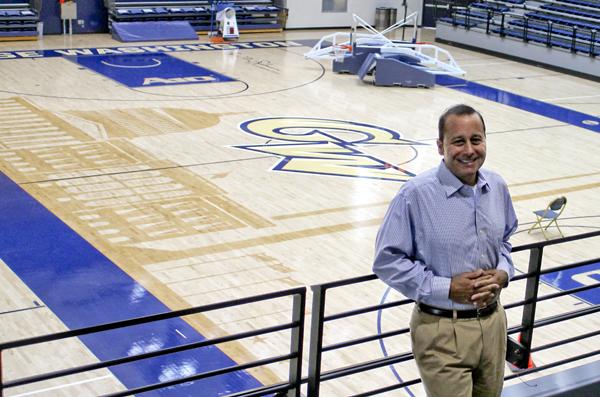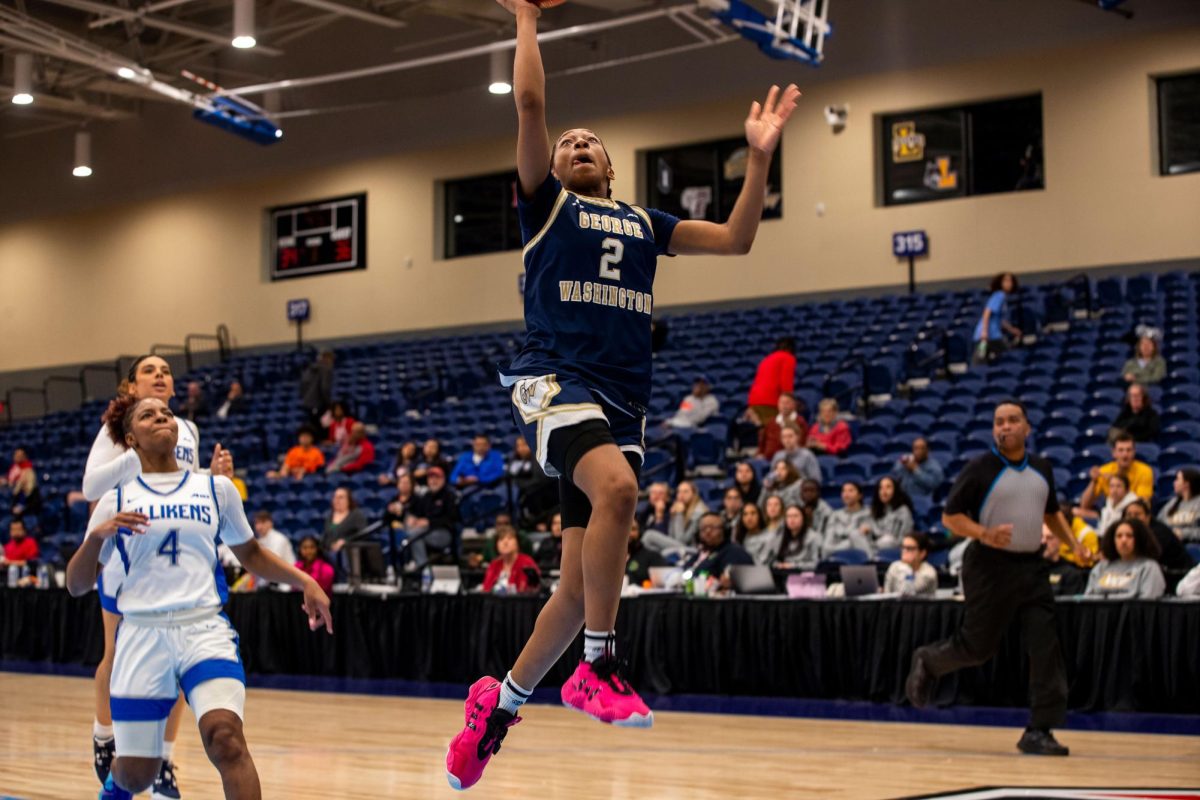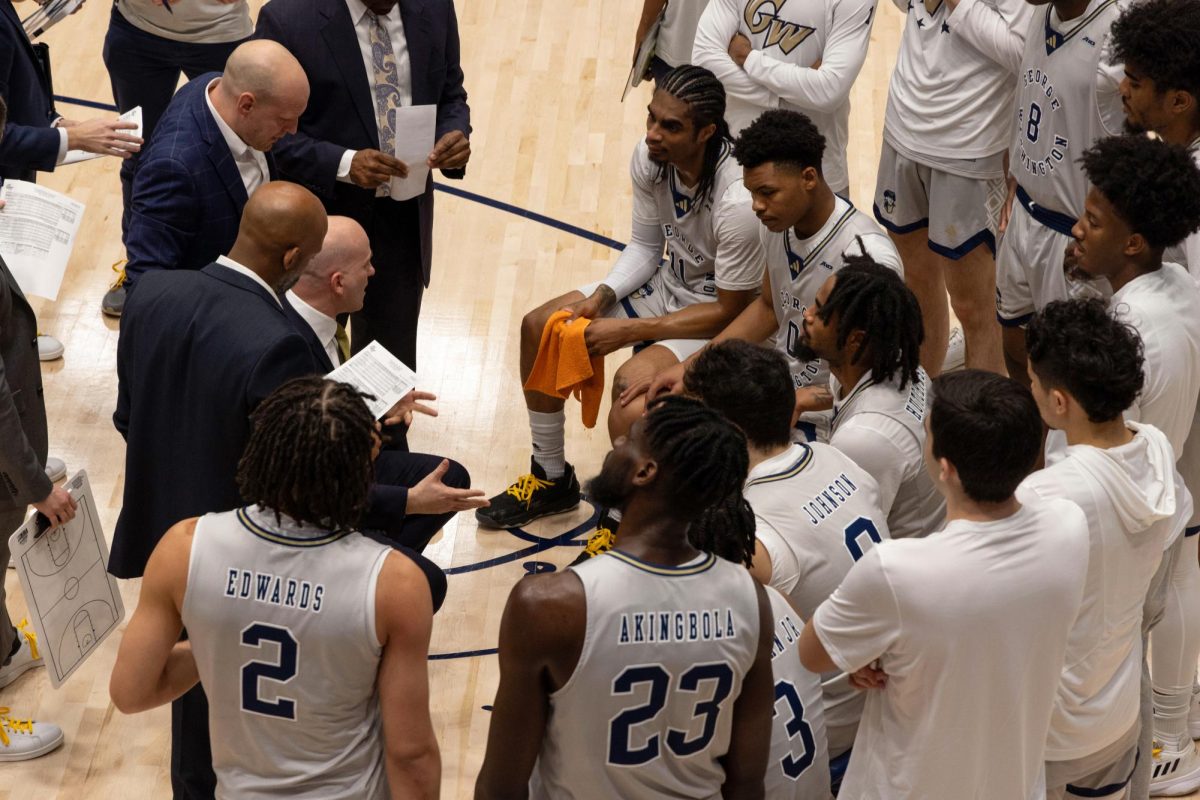
Upon her recruiting visit to GW last fall, freshman softball outfielder Marissa Mangini was asked her top three reasons for wanting to become a Colonial. The first two answers she listed off – GW’s location and academic prowess – have been common for the last couple decades.
But her third answer – facilities – is a new response, and is becoming increasingly common as GW tries to lay the groundwork for an athletics resurgence. The millions of dollars spent on new athletics training facilities, refurbished courts and spruced-up playing fields over the last few years seem to be leading to a recruiting boom.
“On some of the other visits I went on, the fields were more like [recreational] fields, I guess you could say. Very low-maintenance, nothing special,” said Mangini, a three-time first-team All-State selection in Florida.
“But when I came to GW, we now have a turf outfield, and I play outfield, so that’s awesome,” she added.
Athletics department officials are seeing that more highly coveted high school stars are picking GW over Bowl Championship Series teams, other Atlantic 10 schools and some Ivy League colleges because of the University’s new facilities.
Just this season, the women’s volleyball and baseball teams have seen one of their best and largest recruiting classes in recent years, with the women’s basketball team patiently prepared for a stellar 2014 class.
Every summer, the athletics department hosts hundreds of sought-after athletes who are asked to complete a survey that details the other schools they are considering and the reasons they would want to come to GW.
In 2012, more than 150 athletes took the survey, with none saying that facilities would factor into their decisions to don Colonials’ uniforms. But this summer, 60 percent of the 157 potential recruits put facilities among their top three reasons for wanting to play at GW, just behind academics and location on the survey.
“Coaches all over the place will tell you that facilities are important, and we’ve addressed a lot of that,” athletics director Patrick Nero said.
GW, of course, isn’t coming close to putting up the kinds of $100-million locker rooms and stadiums seen at sports behemoths like Oregon or Alabama. But since Nero put in motion an athletic strategic plan in 2012, athletes have seen an explosion of upgrades to facilities.
On the Mount Vernon Campus, the University resurfaced and redesigned both the soccer field and tennis courts. In Arlington, Va., GW put $3 million into renovations for its baseball field, Barcroft Park, which now boasts a turf field, batting cage and press box. In the Smith Center basement, GW installed a fully equipped golf simulator and indoor batting cages, in addition to the nationally recognized new basketball court design.
The upgrades carry over the momentum from the $40 million renovation of the Smith Center that was completed three years ago.
Next week, state-of-the-art locker rooms in the Smith Center are set to be revealed. The department would not yet reveal when exactly the locker rooms will open, and declined to provide a cost of the renovations. Officials said the renovations would be paid for with fundraising dollars from the Buff and Blue fund.
The renovations partially stem from GW drawing up its own halftime strategy to bring life back to the athletics department. After a committee of trustees and administrators found that GW’s athletics budget floundered toward the back of the A-10, the department has seen more internal dollars and bulked-up fundraising. It raised more than $1 million last year, and is gunning for more this year.
“I think each of the programs are feeling it. I think it, again, reinforces to them, ‘Hey, you have a university that is supporting you,'” Nero said, “And I think that results in them putting a much different focus on their athletic competition.”
The added dollars play toward the Colonials’ natural financial advantage, as GW has the second-largest endowment in the A-10, trailing only Richmond.
More than just facilities
Nero has done more than just bring an array of construction workers to campus, though. He has also attracted a new breed of head coaches – all with long lists of credentials – that are doing their own part in attracting recruits.
“The facilities have been the most drastic sign that people see everyday, but I would say internally, the student athletes and staff and coaches would say that a – what we would call a ‘Raise High’ attitude, is very different,” Nero said. “Everyone here understands that being a Division I athlete means that you take pride in representing your university and wanting to win, and that’s become a very big focal point.”
For three years, freshman point guard Shannon Cranshaw was committed to play women’s basketball at the University of Georgia, a team that has been nationally ranked in the Top 25 every year since she joined the team.
Coaching changes at Georgia and a realization her senior year about wanting to build a better life after college basketball, however, led her away from Athens, Ga. and straight to the Smith Center.
Facilities upgrades, like the new court and locker room designs, were key factors in Cranshaw’s decision, she said, but the biggest was the opportunity to play under a high-level coach like Tsipis.
“The reason, in the end, from a basketball perspective, was to play under a coaching staff of Coach Tsipis and his associate head coaches and assistant coaches, and just the opportunity to be a part of a program that’s on the rise.”
The idea of “stealing” recruits away from marquee sports programs – like Cranshaw’s example – is still a work in progress for Nero and company.
According to GW’s 2012 recruiting survey, 14 of the 150 athletes visiting also considered BCS schools, nine were looking at Ivy League schools, and nine other A-10 schools.
This past summer – just a year later – the number of BCS schools jumped to 24, Ivies to 41, and A-10 schools to 28.
“For us, it’s continuing to target a high school student who is achieving at a very high level academically, but also can be athletically similar to one of the top athletes in the country,” Nero said.
Internal development
Recruiting is a tricky business. So tricky that the NCAA has pages upon pages of regulations regarding when and how a coach can contact a player. There are cross-country flights, meetings in familys’ living rooms and usually about 20 other schools doing the same thing for the same player.
It gets even trickier for GW, a school that prides itself on being a research institution of high academic standing. Finding kids that excel both on the field and in the classroom greatly reduces the recruiting pool that GW can choose from.
“I leave the specifics of those kids to the coaches. Our job is saying, ‘All right, what is it gonna take,'” Nero said. “Why would a student from San Francisco wanna come to GW and row if they’re a top student, you know, over the Ivies, Stanford, Washington, [California at Berkeley]?”
But in his short time at GW, Nero has fostered an attitude throughout the athletics department that puts the success of all programs, not just basketball, as the top priority. A recent example: the reinstatement of the track and diving programs, moves that will do little financially for the department, but gives the cross country and swimming teams a greater chance at an A-10 championship.
That type of change may be hard to determine on a survey, but to the recruits and current student-athletes, it’s important.
“When you think of other schools, you think of like football or basketball programs, but the fact that they put so much into softball because it’s such a growing program, it’s really awesome to see that,” Mangini said. “That’s one of the reasons I chose GW, because it had the academic, but they also had the athletic part; that they care about softball, which is a sport that not a lot of people watch or think is interesting.”








